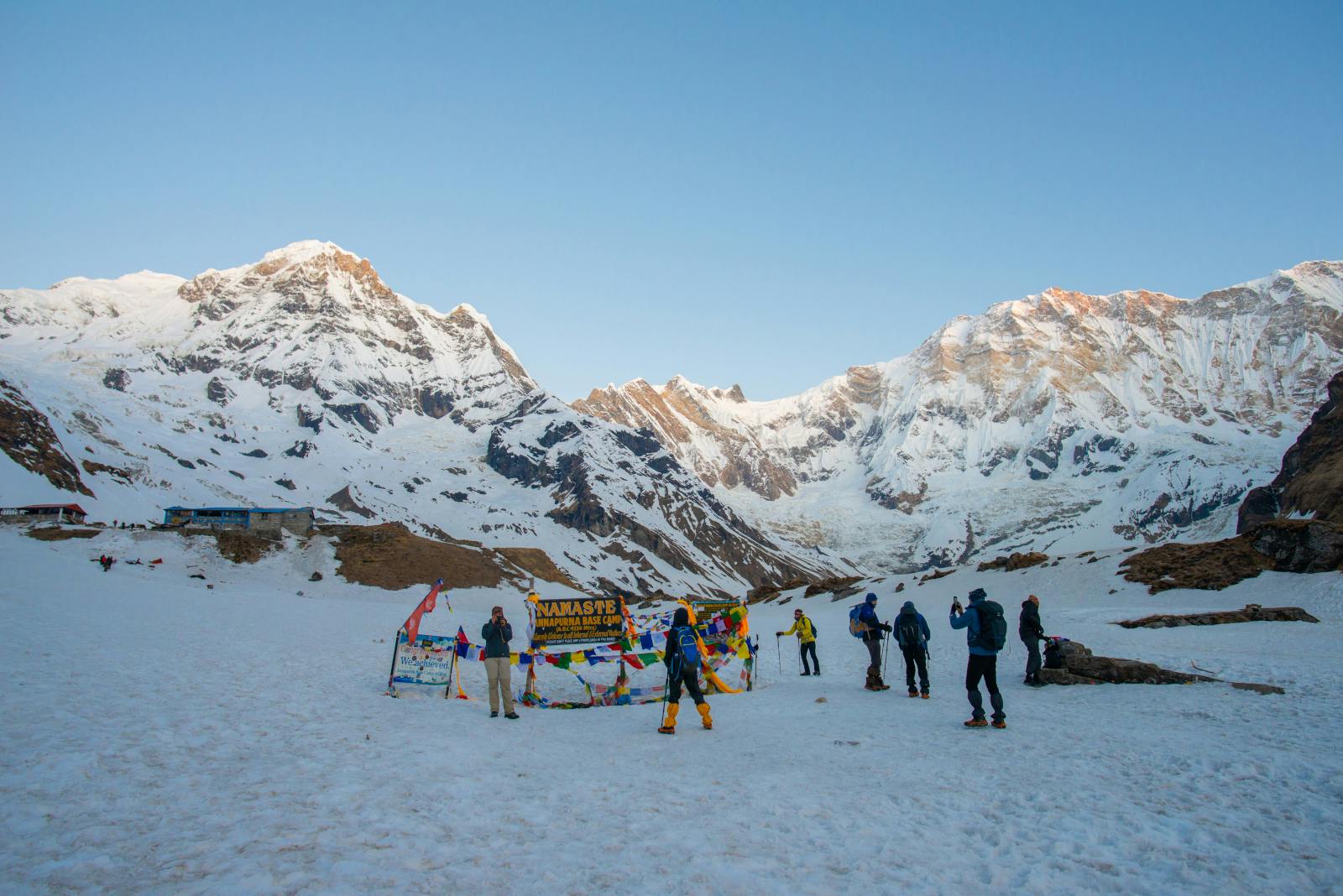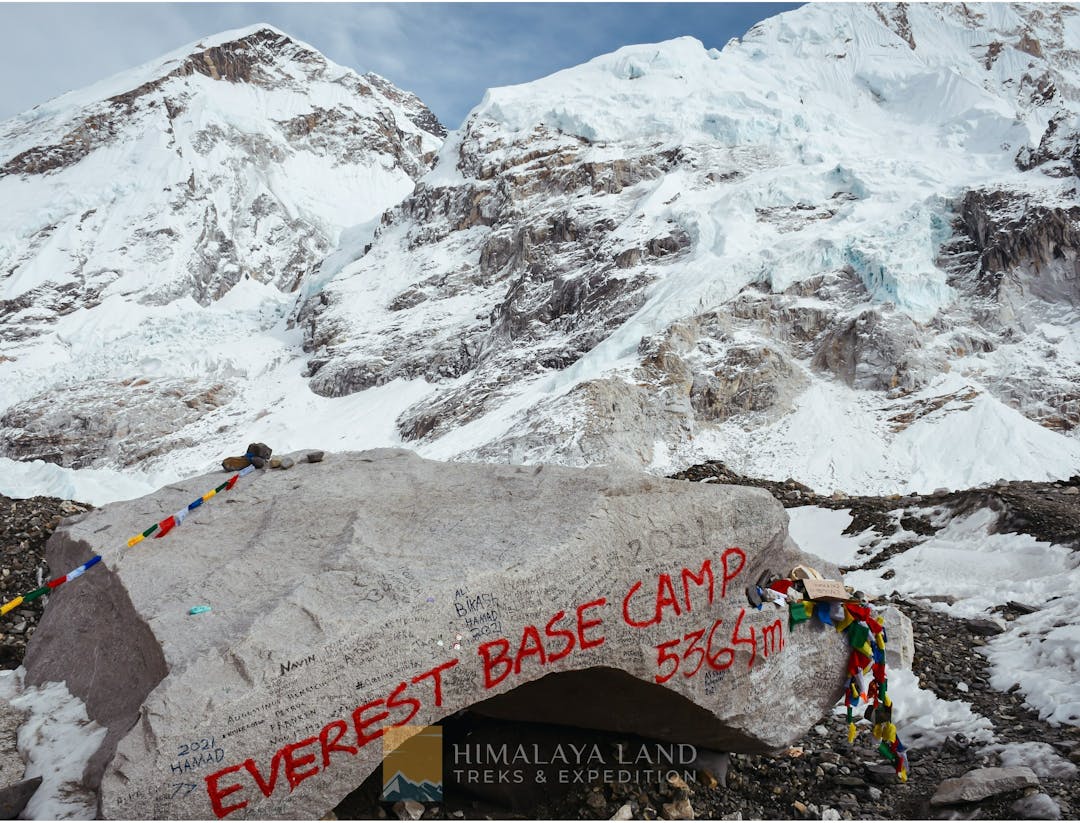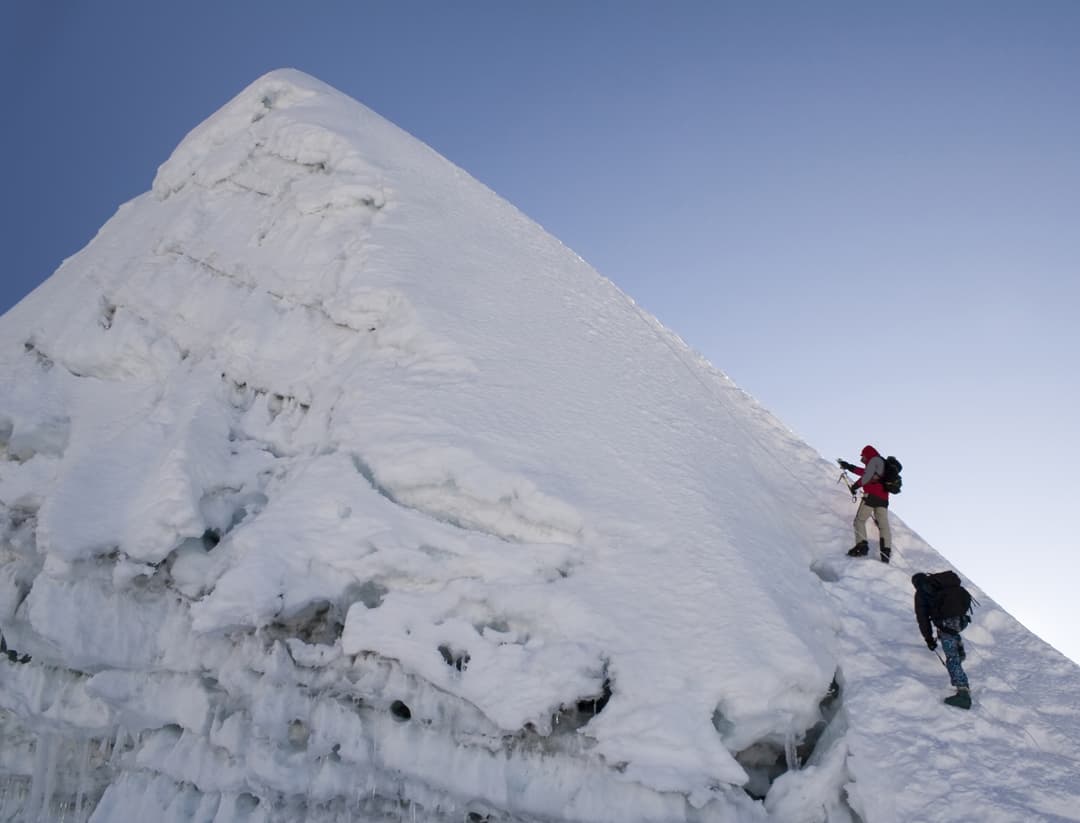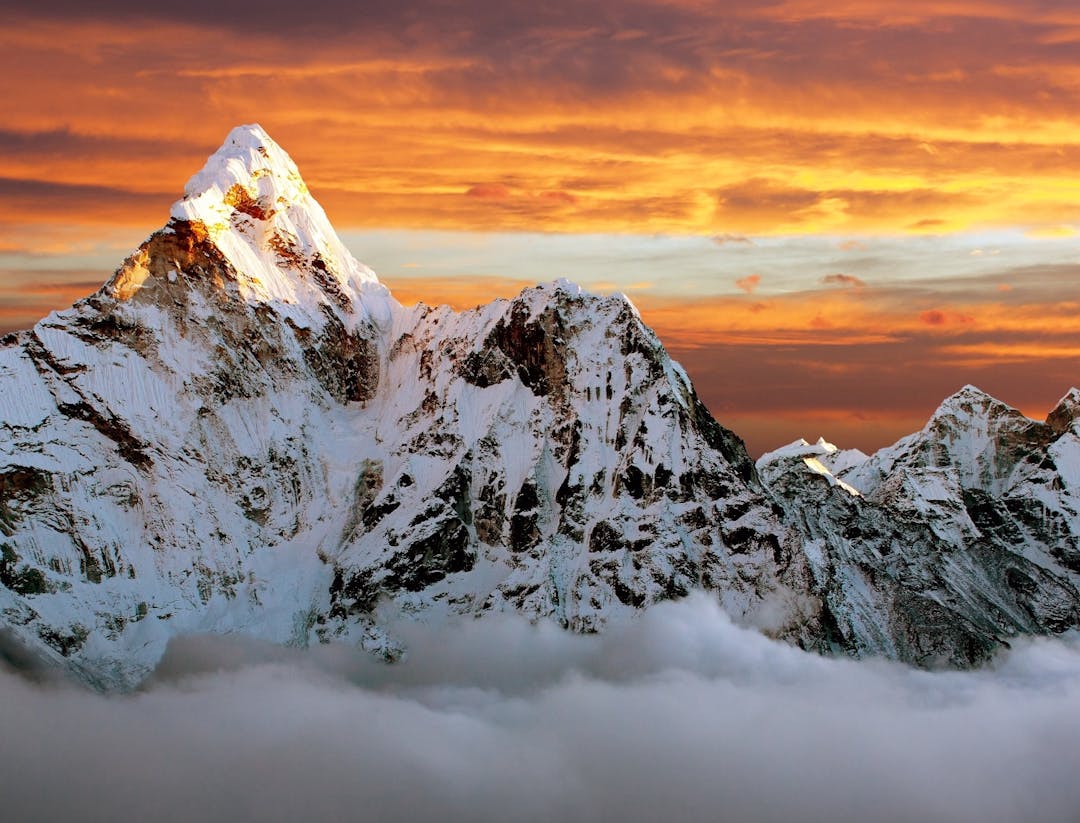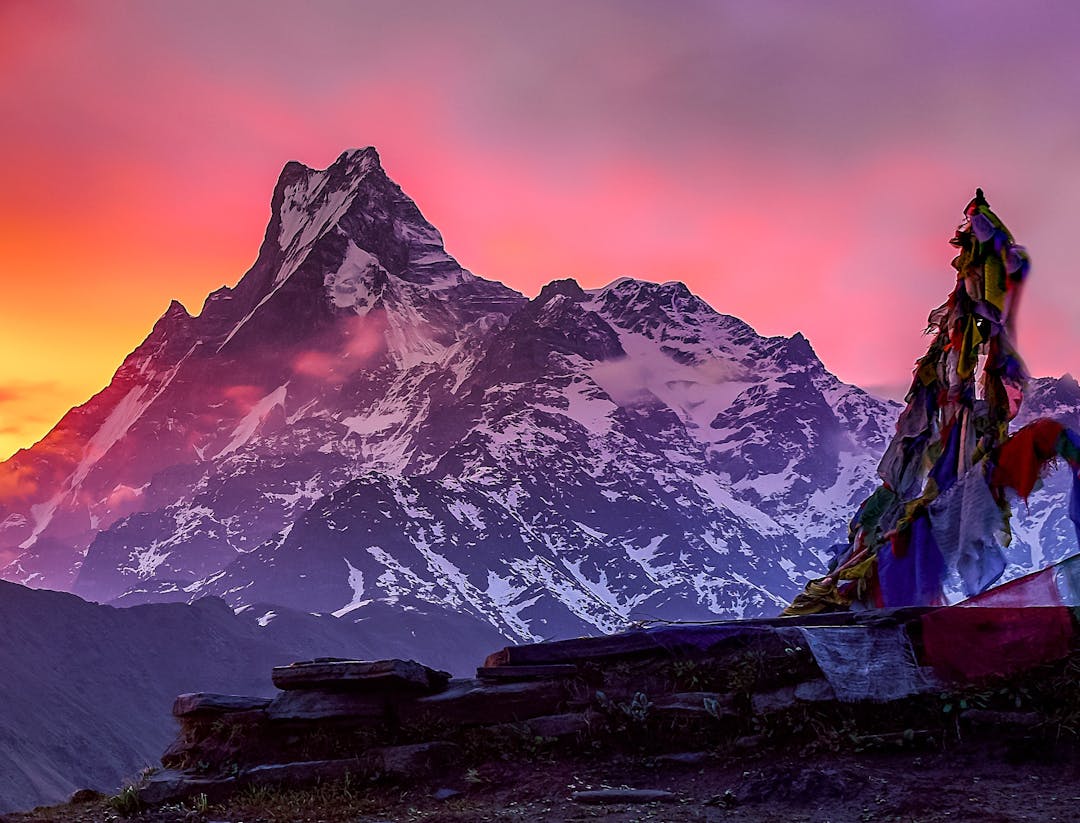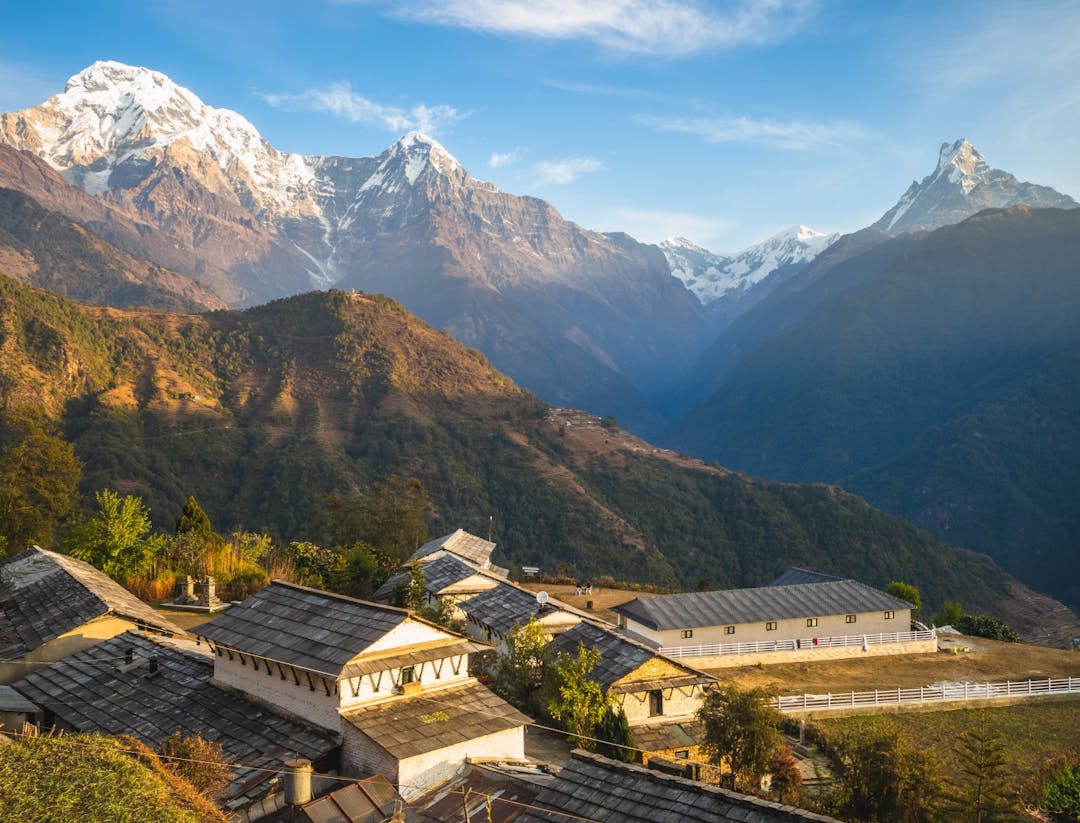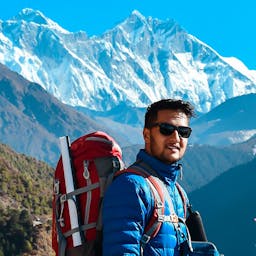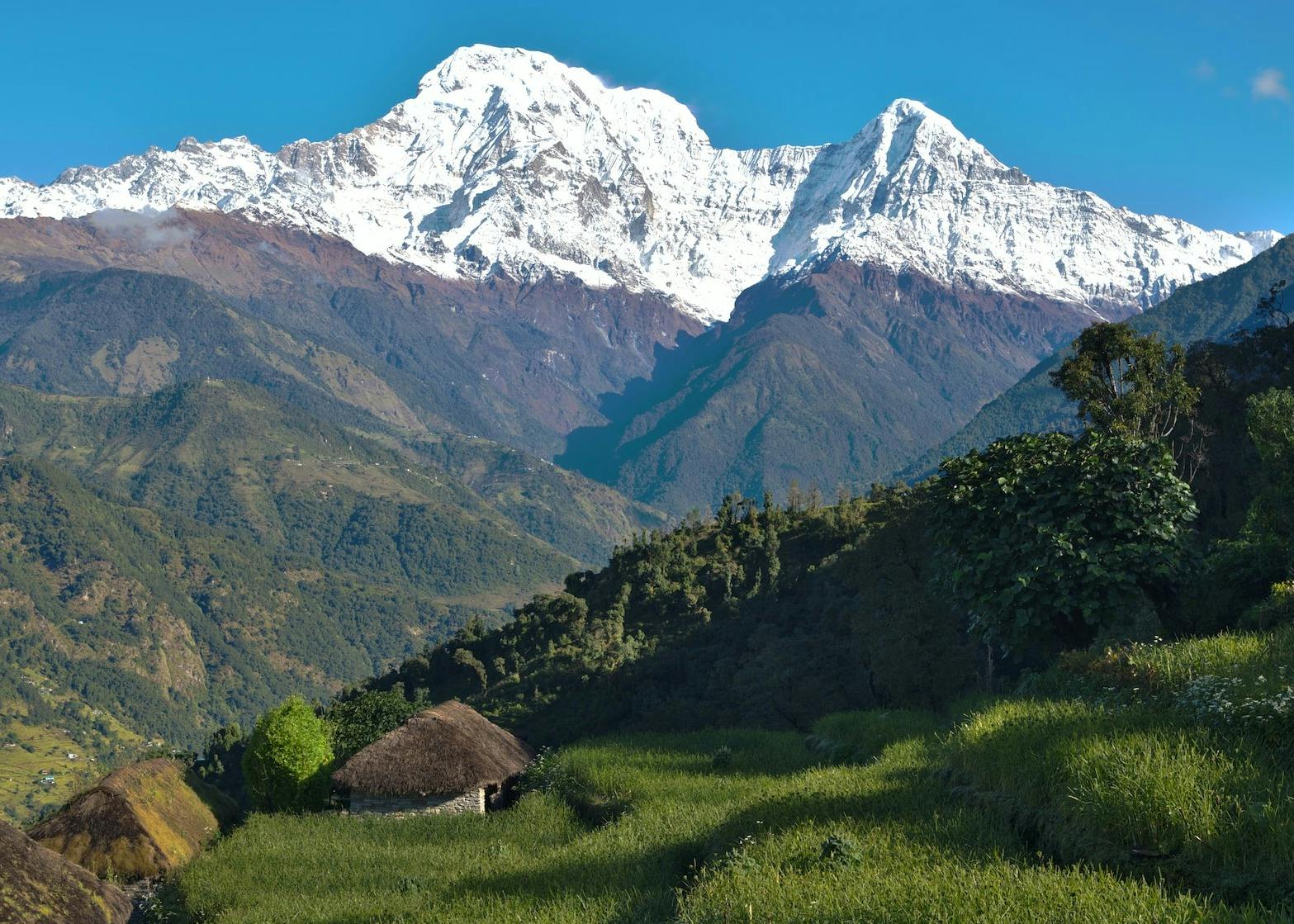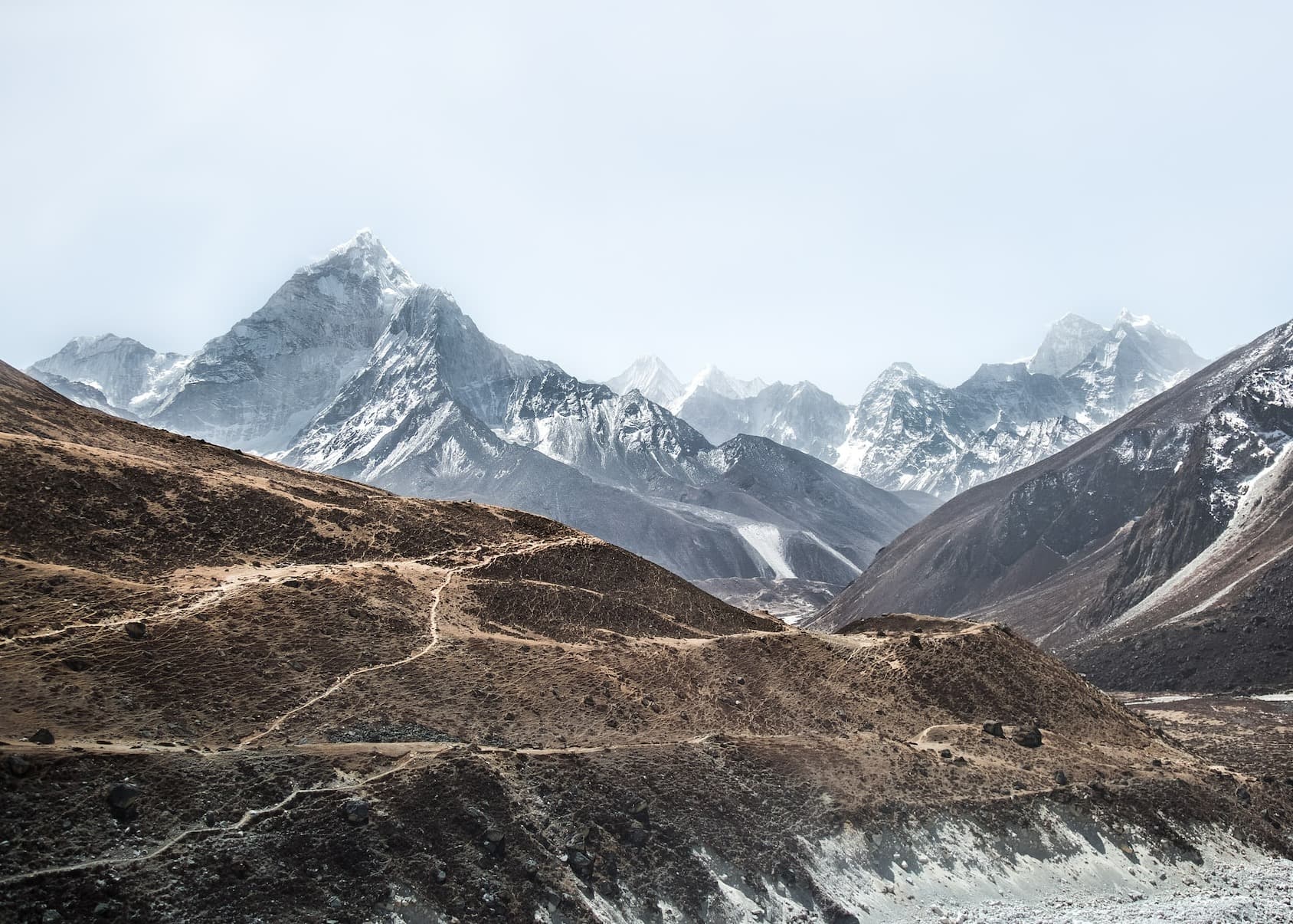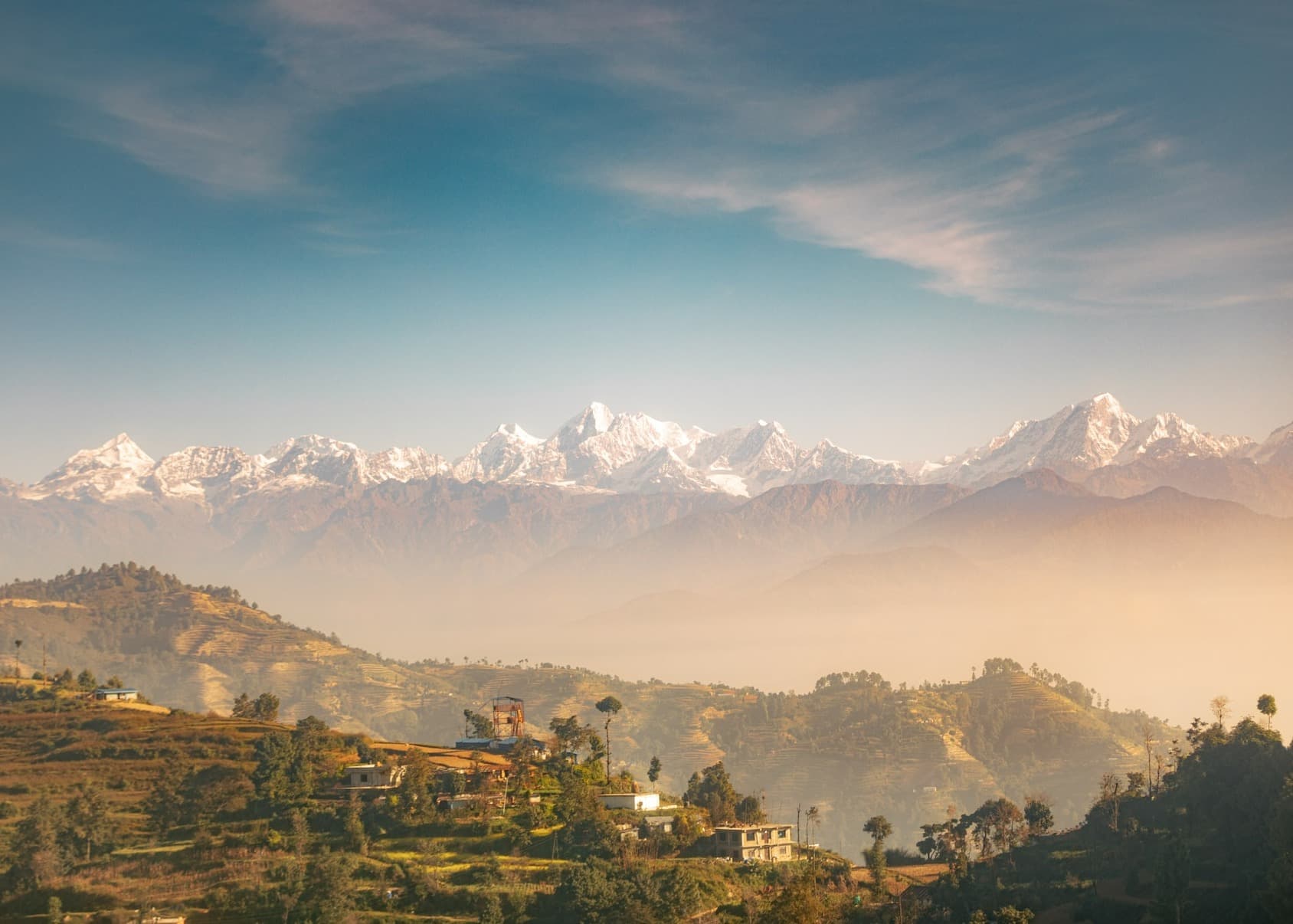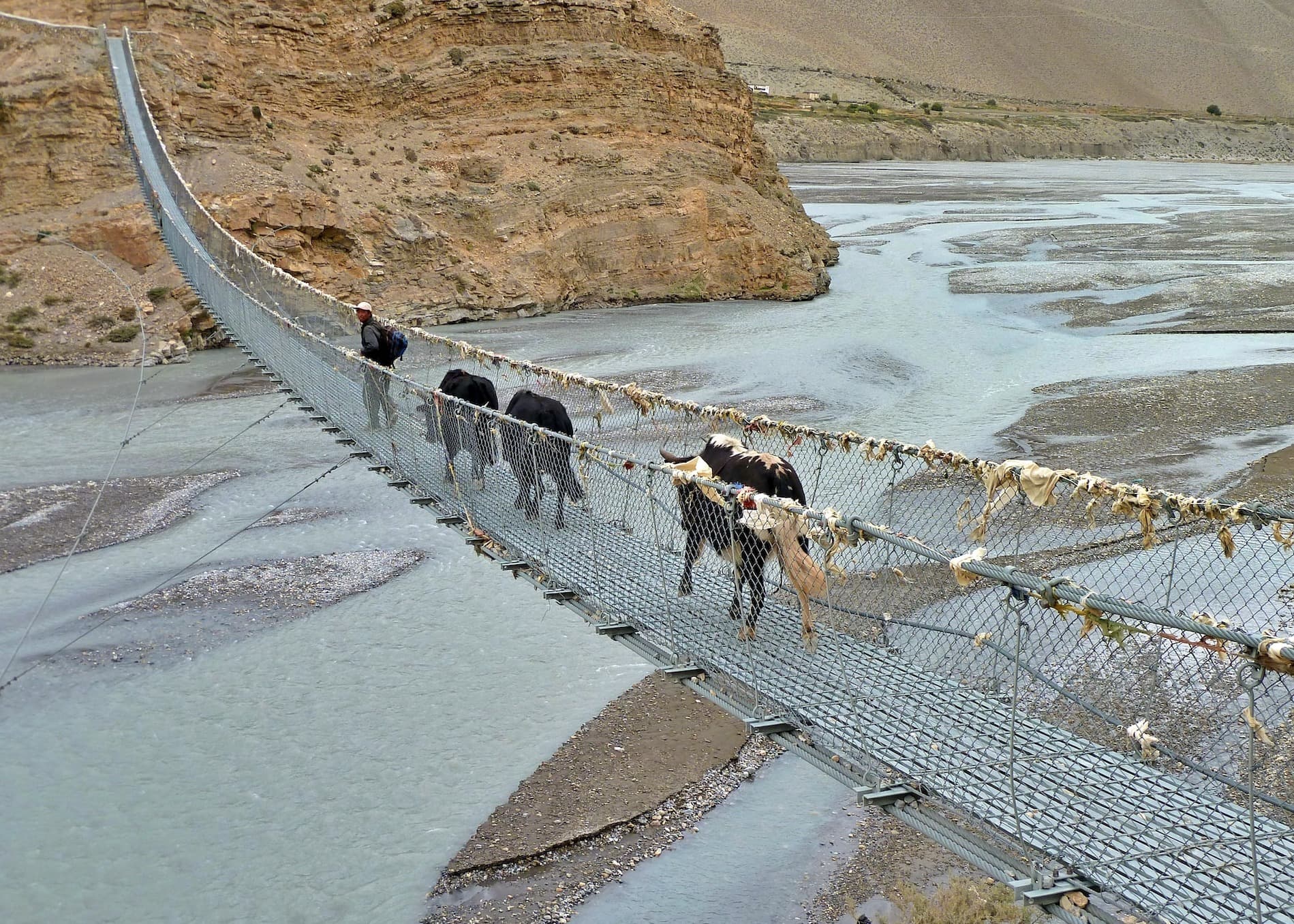- Annapurna Base Camp Trek Cost 2023/2024
- Annapurna Base Camp trek Difficulty
- A Detailed Route and Itinerary Guide
- Key Landmarks
- A Journey through Enchanting Landscapes
- Annapurna Base Camp Trek's Cultural Insights
- Preparation and Training
- Mental Preparation
- A Seasonal Guide to Annapurna Base Camp
- Accommodations and Facilities on the ABC Trek
- Safety and Health Tips for a Successful ABC Trek
- Travel Insurance
- Personal Experiences and Stories
- Photography and Visuals
- Responsible and Sustainable Trekking Practices
- Engaging in Responsible Trekking Activities
Embark on an unforgettable adventure to the Annapurna Base Camp (ABC), where towering peaks, breathtaking landscapes, and vibrant cultural experiences await. We delve into the wonders of the Annapurna Base Camp trek, offering a comprehensive guide and personal insights to inspire and inform your own journey.
Discover the allure of the Annapurna region, renowned for its pristine beauty and diverse landscapes. Take your readers on a virtual tour, painting vivid descriptions of lush forests, terraced fields, serene alpine meadows, and the commanding presence of snow-capped peaks. Set the stage for an awe-inspiring trekking experience.
Annapurna Base Camp Trek Cost 2023/2024
The cost of the Annapurna Base Camp trek can vary depending on various factors such as the duration of the trek, the level of comfort you seek, and the services you opt for. It's important to note that the cost you provided seems to be a breakdown of the trek cost per person based on group size, with discounts offered for larger groups.
Here is a breakdown of the cost based on group size:
| 1 person | USD 1350 |
| 2-4 persons | USD 1250 per person |
| 5-8 persons | USD 1200 per person |
| 9-15 persons | USD 1150 per person |
It's worth mentioning that these costs typically include permits, accommodations, meals, a guide, and porters. However, it's important to confirm the specific inclusions with the trekking agency or operator you choose, as the services and amenities covered can vary.
Group discounts are a common practice in the trekking industry to encourage larger groups to trek together. The discounts are usually applied per person, which means the overall cost for the group will be lower than if each individual were to trek separately.
When considering the cost, it's also essential to factor in additional expenses such as flights to and from Nepal, travel insurance, equipment rentals or purchases, and personal expenses. These costs may not be included in the package price and should be budgeted accordingly.
To ensure an accurate understanding of the cost and the specific services included in the package, it's recommended to contact the trekking agency or operator directly. They will provide you with comprehensive information about the inclusions, exclusions, and any additional costs associated with the Annapurna Base Camp trek.
Annapurna Base Camp trek Difficulty
The Annapurna Base Camp (ABC) trek is considered to be moderately challenging in terms of difficulty. While it doesn't require technical climbing skills, it does demand a good level of physical fitness and some previous hiking experience.
Here are some factors that contribute to the moderate difficulty level of the Annapurna Base Camp trek:
Altitude: The trek takes you to an altitude of 4,130 meters (13,549 feet) at Annapurna Base Camp. As you ascend, the air becomes thinner, and the oxygen levels decrease. Altitude sickness can be a concern for some trekkers, so it's crucial to acclimatize properly, ascend gradually, and be aware of any symptoms of altitude sickness.
Trekking Duration: The ABC trek typically takes around 7 to 12 days, depending on the chosen itinerary. Walking for several hours each day, often uphill and downhill, can be physically demanding. The duration of the trek requires stamina and endurance, especially as you gain elevation.
Terrain: The trail consists of a variety of terrains, including well-defined paths, rocky sections, and some steep ascents and descents. There are stone steps, uneven surfaces, and occasional river crossings. Good balance and stability are important to navigate the terrain safely.
Weather Conditions: Weather conditions in the Annapurna region can be unpredictable, especially at higher altitudes. During the trekking season, you can expect pleasant daytime temperatures ranging from 10 to 20 degrees Celsius (50 to 68 degrees Fahrenheit) at lower elevations. However, the temperatures drop significantly as you ascend, and nighttime temperatures can fall below freezing. Additionally, rain and snowfall are possible, so being prepared with appropriate clothing and gear is essential.
Distance and Daily Walking Hours: The trek covers a distance of approximately 110 kilometers (68 miles) round trip. On average, you can expect to walk for 4 to 6 hours per day, with some longer days. The duration and distance covered each day can vary depending on your fitness level, acclimatization needs, and the chosen itinerary.
Despite these challenges, with proper physical preparation, adequate acclimatization, and a gradual ascent, the Annapurna Base Camp trek is achievable for most individuals with a reasonable level of fitness. Hiring an experienced guide and/or porter can also help alleviate some of the physical strain and enhance your overall trekking experience.
It's important to consult with a trekking agency or experienced trekkers for personalized advice and to ensure you are well-prepared for the challenges and requirements of the Annapurna Base Camp trek.
A Detailed Route and Itinerary Guide
This trekking route takes you through awe-inspiring natural beauty, charming villages, and iconic landmarks. In this blog, we present a comprehensive guide to the trekking route and offer various itinerary options to cater to different preferences and fitness levels.
The Trekking Route
The Annapurna Base Camp trek begins in Nayapul, a small town located about an hour's drive from Pokhara. From there, the trail winds its way through lush forests, terraced fields, and picturesque villages, gradually ascending towards the base camp.
Key Landmarks
Ghorepani Poon Hill
Ghorepani Poon Hill is a renowned stop on the Annapurna Base Camp trek that offers breathtaking sunrise views over the Annapurna and Dhaulagiri mountain ranges. Here's a deeper look into what makes Ghorepani Poon Hill such a popular and captivating destination:
Scenic Beauty: Located at an elevation of 3,210 meters (10,531 feet), Ghorepani Poon Hill is surrounded by lush rhododendron forests and panoramic mountain vistas. The picturesque landscape provides a serene and enchanting atmosphere, making it a favorite spot for trekkers to witness the beauty of the Himalayas.
Sunrise Spectacle: One of the main highlights of Ghorepani Poon Hill is the awe-inspiring sunrise view. Early in the morning, trekkers ascend to the viewpoint to witness the first rays of sunlight painting the snow-capped peaks with hues of golden and pink. The sight of mountains like Annapurna I (8,091 meters/26,545 feet) and Dhaulagiri (8,167 meters/26,795 feet) emerging from the darkness is truly a magical experience.
Panoramic Mountain Views: From the viewpoint at Poon Hill, trekkers are treated to a spectacular 360-degree panorama of the Annapurna and Dhaulagiri mountain ranges. The sight of towering peaks, including Annapurna South, Annapurna II, Annapurna III, Annapurna IV, Hiunchuli, and Machhapuchhre (Fishtail), creates an unforgettable backdrop against the clear morning sky.
Cultural Encounters: Ghorepani Poon Hill is also an opportunity to experience the rich local culture and traditions of the Gurung and Magar ethnic communities. The village of Ghorepani itself offers a glimpse into the traditional lifestyle and warm hospitality of the locals. Trekkers can engage with the friendly villagers, sample local cuisine, and explore the traditional architecture and customs.
Trekking Convenience: Ghorepani Poon Hill is easily accessible and is often included as a natural acclimatization point during the Annapurna Base Camp trek. Many trekkers choose to spend a night in Ghorepani before ascending to the viewpoint for sunrise. This allows for a gradual acclimatization process and breaks up the trek, making it more manageable and enjoyable.
Photography Opportunities: With its stunning natural surroundings and captivating mountain views, Ghorepani Poon Hill provides an ideal setting for photography enthusiasts. The play of light and shadow during sunrise, the vibrant colors of the rhododendron forests, and the majestic Himalayan peaks offer endless opportunities to capture breathtaking shots.
Whether you're an avid trekker seeking unforgettable mountain views or a nature lover looking to immerse yourself in the beauty of the Himalayas, Ghorepani Poon Hill is a must-visit destination along the Annapurna Base Camp trek. Its unique combination of natural beauty, cultural encounters, and awe-inspiring sunrise vistas makes it an unforgettable experience for all who venture there.
Tadapani
Tadapani is a picturesque village located along the Annapurna Base Camp trek route in Nepal. Situated at an elevation of approximately 2,630 meters (8,629 feet), Tadapani offers trekkers a serene and peaceful environment surrounded by lush rhododendron forests.
One of the notable features of Tadapani is its beautiful location, providing breathtaking vistas of the surrounding mountain ranges. As you trek through the dense forests, you'll be treated to stunning panoramic views of snow-capped peaks, including Annapurna South, Machhapuchhre (Fishtail), and Hiunchuli. These majestic mountains create a magnificent backdrop that will leave you in awe.
The village itself is relatively small and consists of a few tea houses and lodges where trekkers can find comfortable accommodation and enjoy warm hospitality. Tadapani is an ideal spot for trekkers to take a break, relax, and soak in the natural beauty of the surroundings.
Tadapani is particularly renowned for its vibrant rhododendron forests. If you undertake the trek during the spring season (March to May), you'll witness these forests in full bloom, with vibrant hues of red, pink, and white flowers carpeting the landscape. This creates a surreal and enchanting atmosphere, adding to the overall charm of the village.
In addition to its scenic beauty, Tadapani serves as a hub for trekkers to interact and connect with fellow adventurers. It provides a chance to share stories and experiences, fostering a sense of camaraderie among trekkers from different parts of the world.
As you continue your trek from Tadapani towards Annapurna Base Camp, you'll traverse through diverse landscapes and encounter more incredible sights along the way. From Tadapani, you can choose to follow the Modi Khola (river) gorge, which leads you deeper into the heart of the Annapurna Sanctuary, eventually reaching the base camp itself.
Tadapani is a gem along the Annapurna Base Camp trek, offering a serene retreat amidst rhododendron forests and captivating mountain views. It provides a tranquil and memorable experience for trekkers, making it a noteworthy stop on the journey towards Annapurna Base Camp.
Chhomrong
Chhomrong, a traditional Gurung village, is a charming settlement that holds a special place along the Annapurna Base Camp trek. Nestled at an altitude of 2,170 meters (7,120 feet), Chhomrong offers trekkers a captivating blend of warm hospitality, rich cultural heritage, and breathtaking panoramic views of the surrounding peaks.
The village is predominantly inhabited by the Gurung ethnic group, known for their distinct culture, traditions, and bravery as former Gurkha soldiers. As you enter Chhomrong, you'll be welcomed by friendly locals who take immense pride in their village and are eager to share their traditions and way of life with visitors.
One of the highlights of Chhomrong is the awe-inspiring view it provides. The village is perched on a hillside, allowing for sweeping vistas of the towering peaks of Annapurna South (7,219 meters/23,684 feet) and Machhapuchhre (6,993 meters/22,943 feet). The sight of these majestic mountains against the backdrop of the village creates a truly unforgettable experience.
Chhomrong also serves as a crucial stopover point for trekkers on their way to Annapurna Base Camp. Its strategic location makes it an ideal place for a rest day to acclimatize before ascending further. The village offers a range of accommodation options, including teahouses and lodges, where trekkers can find respite, enjoy local cuisine, and interact with fellow travelers.
In addition to its natural beauty and warm hospitality, Chhomrong is a gateway to various side excursions and trails. From here, trekkers can venture towards the vantage points of Ghurjung and Landruk, or explore the pristine Jhinu Danda hot springs, where you can relax and rejuvenate after days of trekking.
As you immerse yourself in the village, take the opportunity to engage with the locals, learn about their customs, and witness their cultural traditions. The Gurung people are known for their vibrant festivals, traditional attire, and melodious music and dance performances. It's a chance to gain deeper insights into the local way of life and foster cultural exchanges.
Chhomrong exemplifies the harmonious coexistence between nature and human settlements, offering a glimpse into the authentic mountain life of Nepal. Whether it's the warm smiles of the villagers, the stunning views of the Himalayas, or the cultural richness that surrounds you, Chhomrong is an integral part of the Annapurna Base Camp trek that leaves a lasting impression on every traveler's heart.
Machhapuchhre Base Camp
Machhapuchhre Base Camp (also known as MBC) is a significant location along the Annapurna Base Camp trek. Situated at an elevation of approximately 3,700 meters (12,140 feet), it serves as a crucial resting point before reaching the ultimate destination of Annapurna Base Camp.
Machhapuchhre Base Camp offers trekkers a mesmerizing view of the majestic Machhapuchhre mountain, also known as the "Fishtail" mountain. The distinct shape of Machhapuchhre, resembling a fishtail, makes it one of the most recognizable and iconic peaks in the Annapurna region.
The camp itself is nestled in a serene and picturesque location, surrounded by towering peaks, lush vegetation, and cascading waterfalls. The tranquil atmosphere and stunning natural beauty make it a memorable spot for trekkers to rest and rejuvenate before continuing their journey towards Annapurna Base Camp.
At Machhapuchhre Base Camp, trekkers can witness the panoramic views of the Annapurna massif, including peaks like Annapurna South, Hiunchuli, and Gangapurna. The play of light and shadows on the mountains during sunrise and sunset creates a breathtaking spectacle that leaves a lasting impression.
While Machhapuchhre Base Camp is not the final destination of the Annapurna Base Camp trek, it holds its own allure and significance. Many trekkers choose to spend a night at this camp to soak in the natural beauty and enjoy the tranquil ambiance before proceeding to the main destination of Annapurna Base Camp.
It's worth noting that due to its ecological sensitivity and restricted access, camping is not allowed at the Machhapuchhre Base Camp itself. Instead, teahouses and lodges in nearby settlements provide accommodation options for trekkers. These accommodations offer basic facilities, meals, and a cozy place to rest amidst the pristine mountain environment.
Machhapuchhre Base Camp serves as a stepping stone towards the ultimate goal of reaching Annapurna Base Camp, but its serene setting and stunning views make it a highlight of the Annapurna Base Camp trek. It offers trekkers an unforgettable experience, allowing them to connect with nature, witness the grandeur of the mountains, and appreciate the unique beauty of the Machhapuchhre mountain.
Annapurna Base Camp
Annapurna Base Camp (ABC) is the ultimate destination of the Annapurna Base Camp trek, offering a truly awe-inspiring experience for trekkers. Situated in a natural amphitheater-like sanctuary, it is surrounded by some of the world's highest peaks, including the majestic Annapurna I, which stands at a towering height of 8,091 meters (26,545 feet).
Reaching Annapurna Base Camp is a culmination of days of trekking through diverse landscapes and challenging terrains. As trekkers approach the base camp, they are greeted by breathtaking panoramic views of the surrounding peaks, including Annapurna South, Hiunchuli, Machapuchare (Fishtail), and Gangapurna, among others. The amphitheater-like setting of the sanctuary creates a sense of serenity and tranquility, providing trekkers with a truly immersive and mesmerizing experience.
The journey to Annapurna Base Camp takes trekkers through lush forests, terraced fields, and picturesque villages inhabited by the Gurung and Magar ethnic communities. Along the way, trekkers can witness the rich biodiversity of the region, including rhododendron forests, waterfalls, and diverse flora and fauna.
Upon reaching Annapurna Base Camp, trekkers are rewarded with a surreal view of the towering peaks that encircle the sanctuary. The snow-covered mountains create a dramatic backdrop against the clear blue sky, leaving trekkers in awe of nature's grandeur. The base camp itself is a gathering point for trekkers from around the world, where they can share stories, rest, and soak in the spectacular views.
At Annapurna Base Camp, trekkers have the opportunity to explore the surroundings, taking short hikes to nearby viewpoints for even more breathtaking vistas. The sheer size and beauty of the mountains, combined with the serenity of the sanctuary, make it a remarkable place for reflection, photography, and a sense of achievement.
Reaching Annapurna Base Camp is a significant accomplishment for trekkers, offering a unique perspective on the grandeur of the Himalayas. The combination of natural beauty, the sense of adventure, and the achievement of reaching the base camp make the Annapurna Base Camp trek a truly unforgettable experience.
Classic 10-day Itinerary
- Day 1: Nayapul to Tikhedhunga
- Day 2: Tikhedhunga to Ghorepani
- Day 3: Ghorepani to Tadapani (via Poon Hill)
- Day 4: Tadapani to Chhomrong
- Day 5: Chhomrong to Bamboo
- Day 6: Bamboo to Deurali
- Day 7: Deurali to Machhapuchhre Base Camp
- Day 8: Machhapuchhre Base Camp to Annapurna Base Camp
- Day 9: Annapurna Base Camp to Bamboo
- Day 10: Bamboo to Nayapul
We also provide 14-days itinerary for Annapurna Base Camp. For those seeking a more relaxed pace or additional exploration, this itinerary allows for extra acclimatization days and side trips to nearby attractions such as Jhinu Danda hot springs.
- Day01: Arrival at Kathmandu (1,320m/4,330ft)
- Day02: Drive from Kathmandu to Pokhara (820m/2690ft)
- Day03: Drive to Nayapul (1070m/3510ft) and trek to Tikhedhunga (1540m/5052ft)
- Day04: Trek from Tikhedhunga to Ghorepani (2880m/9449ft)
- Day05: Trek to Poon Hill (3210m/10532ft) and to Tadapani (2620m/8596ft)
- Day06: Trek from Tadapani to Sinuwa (2360m/7743ft)
- Day07: Trek from Sinuwa to Deurali (3230m/10597ft)
- Day08: Deurali to Annapurna Base Camp (4130m/13550ft)
- Day09: Trek from ABC to Bamboo (2300m/7546ft)
- Day10: Trek from Bamboo to Jhinu Danda (1770m/5807ft)
- Day11: Trek from Jhinu Danda To Pothana (1890m/6201ft)
- Day12: Trek from Pothana To Phedi (1130m/3707) and Drive to Pokhara
- Day13: Drive to Kathmandu | Farewell Dinner
- Day14: Final Departure Day
Embarking on the Annapurna Base Camp trek is a remarkable adventure that unveils the natural wonders and cultural treasures of the region. By following our detailed route and itinerary guide, you can tailor your trek to suit your preferences and fitness level. Immerse yourself in the breathtaking landscapes, encounter vibrant local communities, and create memories that will last a lifetime on this extraordinary journey to Annapurna Base Camp.
A Journey through Enchanting Landscapes
Embarking on the Annapurna Base Camp trek is like stepping into a realm of unparalleled natural beauty. The Annapurna region boasts a diverse tapestry of landscapes, where lush forests, terraced fields, alpine meadows, and towering snow-capped peaks converge. In this blog, we invite you to immerse yourself in the awe-inspiring scenery of this Himalayan wonderland. Through vivid descriptions, captivating photographs, and personal experiences, we will transport you to the breathtaking landscapes of the Annapurna region.
Verdant Forests
As you begin your trek, you'll find yourself surrounded by verdant forests teeming with life. Towering rhododendron trees form a vibrant canopy, dappled with hues of red, pink, and white during the spring season. The air is filled with the sweet fragrance of blooming flowers, while the melodic chirping of birds creates a symphony of nature. Capture the ethereal beauty of these forests as you weave through winding trails, occasionally glimpsing majestic waterfalls cascading down moss-covered cliffs.
Terraced Fields
Venturing further into the Annapurna region, you'll encounter terraced fields that seem to defy gravity. These meticulously carved fields cling to the mountainsides, showcasing the ingenuity of local farmers. Imagine the sight of emerald green rice paddies or golden wheat fields against a backdrop of rugged peaks. Witness the rhythm of rural life as villagers tend to their crops, providing a glimpse into the symbiotic relationship between humans and nature.
Alpine Meadows
Ascending higher, you'll enter the realm of alpine meadows, where the landscape opens up to reveal vast stretches of rolling hills adorned with colorful wildflowers. Picture yourself strolling through carpets of pink primroses, purple irises, and white edelweiss, with panoramic views of the surrounding mountains. The tranquil ambiance of these meadows is an invitation to pause, breathe in the crisp mountain air, and absorb the serenity of your surroundings.
Majestic Snow-Capped Peaks
The grand finale of your journey awaits as you reach Annapurna Base Camp. Here, the towering giants of the Himalayas rise before you, dominating the skyline with their majestic presence. Annapurna I, standing at 8,091 meters (26,545 feet), commands attention, its glistening white peak contrasting against the cerulean sky. As the sun paints the mountains with hues of gold during sunrise or sunset, witness nature's artistry unfolding before your eyes, leaving an indelible imprint on your soul.
The Annapurna region is a visual symphony that leaves trekkers in awe of its natural beauty. From the enchanting forests and terraced fields to the serenity of alpine meadows and the grandeur of snow-capped peaks, every step of the Annapurna Base Camp trek reveals a new facet of this Himalayan paradise. Let the vivid descriptions, captivating photographs, and personal experiences in this blog ignite your wanderlust and inspire you to embark on your own unforgettable journey through the breathtaking landscapes of the Annapurna region.
Annapurna Base Camp Trek's Cultural Insights
Embarking on the Annapurna Base Camp trek offers more than just breathtaking landscapes. It presents an opportunity to delve into the vibrant cultural tapestry of the region. As you traverse the trekking route, you'll encounter the enchanting traditions, rich heritage, and warm hospitality of the local communities, notably the Gurung and Magar ethnic groups. In this blog, we will explore the cultural insights of the Annapurna region, offering a deeper understanding of the unique architecture, festivals, food, and the captivating spirit of its people.
The Gurung and Magar Ethnic Groups
Delve into the fascinating traditions and lifestyles of the Gurung and Magar ethnic groups, who have inhabited the Annapurna region for generations. Discuss their distinct customs, language, and dress, shedding light on their rich cultural heritage and the importance they place on preserving their identity.
Traditional Architecture
Explore the unique architecture that adorns the villages along the Annapurna Base Camp trek. Detail the traditional building techniques, such as intricately carved wooden facades, slate roofs, and stone-paved courtyards. Highlight notable structures like gompas (Buddhist monasteries), chortens (stupas), and the characteristic architecture of teahouses, which are a hallmark of the region.
Festivals and Celebrations
Immerse readers in the vibrant festival culture of the Annapurna region. Discuss significant festivals like Dashain, Tihar, and Lhosar, which bring the communities together in colorful displays of religious rituals, dances, music, and feasts. Describe the unique customs associated with these festivals, and the joyous atmosphere that permeates the villages during these celebrations.
Traditional Cuisine
Take readers on a culinary journey through the traditional food of the Gurung and Magar communities. Describe popular dishes such as dal bhat (lentil soup with rice), momo (steamed dumplings), and gundruk (fermented leafy greens). Highlight the use of locally sourced ingredients and traditional cooking methods, showcasing the flavors that define the region's cuisine.
Warm Hospitality and Homestays
Illustrate the warm and welcoming nature of the local communities. Discuss the possibility of experiencing homestays, where trekkers can immerse themselves in the day-to-day lives of the villagers. Share personal stories of interactions with locals, emphasizing the genuine hospitality and cultural exchange that takes place during these homestay experiences.
Cultural Etiquette
Provide readers with valuable insights into cultural etiquette when interacting with the local communities. Offer guidance on respectful behavior, appropriate attire, and customs to follow during visits to monasteries and religious sites. Encourage trekkers to engage in meaningful conversations and embrace the opportunity to learn from the locals.
Cultural Preservation Efforts
Highlight the initiatives and organizations dedicated to preserving the cultural heritage of the Annapurna region. Discuss the importance of sustainable tourism practices that respect and support local traditions. Encourage readers to engage in responsible tourism by contributing positively to the local communities and participating in cultural exchange programs.
Conclusion:
The Annapurna Base Camp trek not only offers panoramic mountain vistas but also serves as a gateway to cultural exploration. By immersing yourself in the traditions, architecture, festivals, cuisine, and warm hospitality of the Gurung and Magar communities, you'll gain a profound understanding of the cultural heritage that defines this enchanting region. Let the Annapurna Base Camp trek be your avenue to discover the heart and soul of the Annapurna region and forge lasting connections with its remarkable people.
Preparation and Training
Embarking on the Annapurna Base Camp trek is an exhilarating and rewarding adventure. However, proper preparation and training are crucial to ensure a safe and enjoyable experience. In this comprehensive guide, we will provide you with practical tips and valuable insights on how to prepare for this extraordinary journey. From physical fitness training to packing essentials and addressing altitude sickness concerns, we'll cover all the necessary aspects of planning and preparation.
Assessing Physical Fitness
Begin your preparation by assessing your physical fitness level. The Annapurna Base Camp trek demands endurance and stamina. Incorporate regular cardiovascular exercises, such as hiking, jogging, or cycling, into your routine. Include strength training exercises to build leg muscles and enhance overall body strength.
Gradual Training Regimen
Start your training well in advance, at least 2-3 months before the trek. Begin with shorter hikes or walks, gradually increasing the duration and difficulty. Aim for regular training sessions to build strength, stamina, and mental resilience. Simulate trekking conditions by hiking on hilly terrains or using a stair climber machine.
Packing Essentials
Pack wisely to ensure comfort and convenience during the trek. Essential items to include are:
- Hiking boots: Choose sturdy, well-fitted boots with ankle support.
- Moisture-wicking clothing: Pack breathable, lightweight, and quick-drying base layers.
- Insulating layers: Carry a warm fleece or down jacket for colder temperatures.
- Waterproof and windproof outer shell: Protect yourself from rain, wind, and snow.
- Trekking pants: Opt for comfortable, quick-dry pants with zip-off options.
- Hat, gloves, and sunglasses: Shield yourself from the sun, cold, and glare.
- Sleeping bag: Ensure a warm and comfortable sleeping arrangement.
- Water bottles or hydration bladder: Stay hydrated during the trek.
- First aid kit and personal medications: Carry essential medical supplies and any required medications.
Required Permits and Documentation
Obtain the necessary permits and documentation before starting the trek. This typically includes the Annapurna Conservation Area Permit (ACAP) and the Trekkers' Information Management System (TIMS) card. Visit the respective offices in Kathmandu or Pokhara to secure these permits.
Altitude Sickness and Acclimatization
Altitude sickness is a serious concern during high-altitude treks. Understand the symptoms, risks, and preventive measures associated with altitude sickness. Gradual acclimatization is crucial to minimize its impact. Plan your itinerary to include rest days and avoid rapid ascents. Stay adequately hydrated, maintain a balanced diet, and listen to your body's signals.
Mental Preparation
Prepare yourself mentally for the challenges you may encounter. The trek requires determination, perseverance, and a positive mindset. Embrace the unpredictable nature of the journey, be flexible, and stay motivated. Engage in relaxation techniques, meditation, or yoga to enhance mental strength and focus.
Proper preparation and training are vital for a successful and enjoyable Annapurna Base Camp trek. By following these practical tips and guidance, you'll be well-equipped physically, mentally, and logistically to undertake this remarkable adventure. Remember, planning, preparation, and a respectful attitude towards nature and local communities will ensure a memorable and fulfilling experience in the breathtaking Annapurna region. Lace up your boots, embark on this life-changing journey, and let the beauty of the Himalayas unfold before you.
A Seasonal Guide to Annapurna Base Camp
Embarking on the Annapurna Base Camp trek is a dream for many outdoor enthusiasts. With its stunning landscapes, rich cultural encounters, and breathtaking views of the Himalayas, this trek offers an unforgettable experience. One crucial aspect to consider when planning your trek is the season in which you'll embark on this incredible adventure. In this blog, we will explore the seasonal considerations for trekking the Annapurna Base Camp, highlighting the pros and cons, weather patterns, crowd levels, and unique experiences that await you.
Spring (March to May)
Spring is a popular time for the Annapurna Base Camp trek, and for good reason. As winter fades away, the region bursts into a riot of colors with blooming rhododendron forests. The weather during spring is generally mild and pleasant, offering clear skies and moderate temperatures. This season provides excellent visibility, allowing trekkers to feast their eyes on the majestic peaks, including Annapurna and Machhapuchhre (Fishtail). However, be prepared for occasional rain showers and the possibility of some cloud cover. The trails can get busy during this time, but the lively atmosphere and vibrant nature make it a delightful experience.
Summer (June to August)
While summer brings warmer temperatures to the region, it is also the monsoon season in Nepal. Trekking during this time can present a unique set of challenges. On the bright side, the landscapes are exceptionally lush and vibrant, with cascading waterfalls and blooming wildflowers. The trail is relatively less crowded, allowing for a more peaceful trekking experience. However, be prepared for heavy rainfall, leeches, and occasional landslides, which can make the trail slippery and more challenging. Proper waterproof gear and caution are essential during summer treks.
Autumn (September to November)
Considered the best season for the Annapurna Base Camp trek, autumn offers ideal weather conditions and breathtaking views. The skies are generally clear, providing stunning panoramic vistas of the surrounding peaks. The temperatures are mild, making for comfortable hiking during the day and cool evenings. Autumn also offers a chance to witness colorful landscapes as the forests transition to golden hues. As one of the peak trekking seasons, expect moderate crowds on the trail. It is advisable to make accommodation and permit arrangements in advance to secure your preferred options.
Winter (December to February)
Winter brings colder temperatures and occasional snowfall to the Annapurna region. While trekking during this season may not be as popular, it offers a unique and tranquil experience for adventurous trekkers. The trails are quieter, and the views are breathtaking with snow-covered landscapes. However, be prepared for sub-zero temperatures, especially at higher altitudes. Adequate cold-weather gear and careful attention to weather forecasts are crucial. Trekking in winter requires more caution and preparedness, but the rewards are extraordinary for those seeking solitude and a true winter wonderland experience.
Choosing the right season for your Annapurna Base Camp trek is essential to enhance your overall experience. Each season has its own charm, challenges, and unique perspectives to offer. Whether you opt for the blooming rhododendrons of spring, the lush greenery of summer, the vibrant colors of autumn, or the serene snowscapes of winter, the Annapurna Base Camp trek will undoubtedly leave an indelible mark on your soul. Consider your preferences, weather conditions, and the type of experience you seek, and get ready to embark on a remarkable journey through the stunning Himalayan landscapes.
Accommodations and Facilities on the ABC Trek
Embarking on the Annapurna Base Camp trek is an incredible adventure, and ensuring comfortable accommodations along the way is crucial. From rustic teahouses nestled in picturesque villages to the option of camping under the starry Himalayan sky, the trek offers a range of accommodation choices. In this blog, we will explore the different options available, discussing their amenities, services, and general conditions to help you make informed decisions and have an unforgettable experience.
Teahouses: Authentic Stays in Local Villages
Teahouses are the most common form of accommodation along the Annapurna Base Camp trek. These rustic lodges are usually family-run establishments that provide a warm and welcoming atmosphere. The teahouses offer basic but comfortable rooms with twin beds or dormitory-style sleeping arrangements. While the facilities may be simple, they often provide cozy blankets, hot showers (for an additional cost), and communal dining areas where you can enjoy delicious local meals. Teahouses offer an excellent opportunity to interact with fellow trekkers and experience the local culture firsthand.
Guesthouses: Enhanced Comfort and Amenities
Some villages along the trek route offer guesthouses that provide more amenities compared to teahouses. These guesthouses feature private rooms with attached bathrooms and hot showers. They may also have Wi-Fi access, charging facilities for electronic devices, and common areas to relax and socialize. Guesthouses are an ideal choice for those seeking a balance between comfort and the immersive experience of staying in local villages.
Camping: Immerse Yourself in Nature's Embrace
For trekkers looking for a unique and immersive experience, camping is an option. The Annapurna Base Camp trek offers several picturesque camping spots along the way. Camping allows you to enjoy breathtaking views, tranquility, and a deeper connection with nature. While camping requires more preparation, including carrying your own camping gear or arranging it with a trekking agency, it offers a sense of adventure and a chance to spend nights under the starry Himalayan sky.
Choosing the right accommodation along the Annapurna Base Camp trek is essential for a comfortable and enjoyable journey. Whether you prefer the rustic charm of teahouses, the enhanced amenities of guesthouses, or the immersive experience of camping, there are options to suit every preference. Consider the amenities, services, and recommendations mentioned above to make informed decisions and create lasting memories on your trek. No matter which option you choose, the warmth and hospitality of the Nepali people will ensure your stay in the Annapurna region is truly unforgettable.
Safety and Health Tips for a Successful ABC Trek
Embarking on the Annapurna Base Camp trek is an adventure of a lifetime, but ensuring your safety and well-being throughout the journey is paramount. In this blog post, we will provide you with essential safety and health tips to help you prepare for a successful trekking experience in the Annapurna region. By following these guidelines and taking necessary precautions, you can fully enjoy the beauty of the mountains while minimizing potential risks.
Altitude Sickness Prevention
Altitude sickness, also known as acute mountain sickness (AMS), is a common concern when trekking at higher elevations. To prevent AMS, consider the following:
Gradual ascent: Give your body enough time to acclimatize by taking regular rest days and ascending slowly.
Stay hydrated: Drink plenty of water throughout the trek to avoid dehydration, which can exacerbate altitude sickness.
Listen to your body: Pay attention to any symptoms of AMS, such as headache, nausea, dizziness, or fatigue. If symptoms worsen, descend to a lower altitude and seek medical attention if necessary.
Proper Hydration and Nutrition
Staying properly hydrated and nourished is crucial during the trek. Here are some tips:
- Carry a reusable water bottle or hydration bladder and drink at least 3-4 liters of water daily.
- Consume a balanced diet with carbohydrates, proteins, and healthy fats to fuel your body during the trek.
- Avoid consuming untreated water and uncooked or unhygienic food to prevent waterborne illnesses.
General Safety Guidelines:
Maintaining safety throughout the trek is essential. Consider the following safety tips:
Hire a licensed guide: An experienced guide can provide valuable knowledge, navigation assistance, and emergency support.
Stick to designated trails: Straying from marked paths can be risky, so always follow established routes and signposts.
Be aware of weather conditions: Check the weather forecast regularly and be prepared for changes. Avoid trekking during severe weather conditions.
Dress appropriately: Wear proper trekking gear, including sturdy boots, layered clothing, and a waterproof outer shell, to protect against the elements.
Carry a first aid kit: Pack essential medical supplies, including bandages, antiseptic creams, pain relievers, and any personal medications you may need.
Consult with Medical Professionals
Before embarking on the Annapurna Base Camp trek, it is advisable to consult with medical professionals, such as your doctor or a travel medicine specialist. They can assess your health condition, provide personalized advice, and recommend any necessary vaccinations or medications for the journey.
Travel Insurance
Obtaining travel insurance that specifically covers high-altitude trekking is crucial. Ensure your policy includes coverage for medical emergencies, medical evacuation, trip cancellation, and loss or theft of personal belongings. Carefully review the policy terms and conditions to guarantee it meets your specific needs.
Prioritizing safety and health during your Annapurna Base Camp trek is of utmost importance. By following these safety precautions, practicing good hygiene, and taking necessary steps to prevent altitude sickness, you can have a safe and enjoyable trekking experience. Remember, consulting with professionals, maintaining proper hydration and nutrition, and having comprehensive travel insurance are essential for your well-being on the trek. Embrace the adventure with confidence and cherish the incredible memories you will create amidst the stunning Annapurna mountains.
Personal Experiences and Stories
Embarking on the Annapurna Base Camp trek is not merely a physical challenge; it is a transformative journey that leaves an indelible mark on the soul. In this blog series, we delve into personal experiences, anecdotes, and reflections from trekkers who have embarked on this awe-inspiring adventure. From overcoming daunting obstacles to discovering inner strength, these stories capture the essence of the trek and its potential for personal growth.
Conquering the Heights: A Journey of Self-Discovery
Follow the story of Sarah as she conquers her fear of heights and discovers her inner strength along the Annapurna Base Camp trail. From vertigo-inducing suspension bridges to steep ascents, she shares how each step tested her resolve and allowed her to tap into hidden reserves of determination. Witness her transformation from a hesitant traveler to a fearless adventurer, and how conquering the heights became a metaphor for overcoming life's challenges.
The Kindness of Strangers: Unforgettable Encounters
In this heartwarming account, John recounts the unexpected encounters and acts of kindness he experienced throughout the trek. From the warm smiles and hospitality of local villagers to the camaraderie formed with fellow trekkers, he shares how these interactions shaped his perspective on humanity. Discover how simple gestures and shared experiences can create lifelong memories and forge unbreakable bonds, making the Annapurna Base Camp trek not just a physical journey but a profound social and cultural one.
Finding Solitude: Reflections in the Himalayan Wilderness
Join Emily as she escapes the chaos of daily life and seeks solace in the serene Himalayan wilderness. Through her introspective journey, she reveals the transformative power of solitude and the profound impact it can have on one's self-awareness. From early morning hikes through mist-laden forests to silent contemplation amidst towering peaks, Emily's experiences illustrate how the Annapurna Base Camp trek can be a catalyst for introspection, leading to a deeper understanding of oneself and the world.
Triumph over Adversity: Pushing Boundaries
In this inspiring tale, Mark shares his triumphant journey of pushing beyond his perceived limits. From battling exhaustion and confronting doubt to reaching the summit of Annapurna Base Camp, he reflects on the mental and physical challenges faced along the way. Mark's story serves as a reminder that perseverance, resilience, and unwavering determination can propel us forward, not just in trekking but in every aspect of life.
Lessons from the Mountains: Nature's Teachings
Join Maria as she uncovers the profound wisdom hidden within the majestic Annapurna mountains. Through encounters with nature's raw beauty, she shares the valuable life lessons she gleaned from the trek. From the relentless power of the elements to the delicate balance of ecosystems, Maria's experiences remind us of our connection to the natural world and the importance of preserving it.
These personal stories from the Annapurna Base Camp trek encapsulate the transformative power and profound impact this journey can have on individuals. Through triumphs, challenges, and encounters along the trail, trekkers discover their inner strength, forge deep connections, find solace, and learn invaluable life lessons. By sharing these narratives, we hope to inspire others to embark on their own transformative journey and experience the magic of the Annapurna Base Camp trek.
Photography and Visuals
Embarking on the Annapurna Base Camp trek is a feast for the senses, and one of the best ways to immortalize the experience is through captivating photography. In this blog, we'll delve into the art of visual storytelling, showcasing how high-quality photographs can enhance the narrative of your Annapurna Base Camp adventure. Get ready to be inspired as we guide you through the stunning landscapes, cultural nuances, and the overall trekking experience through the lens.
Immersive Landscapes
The Annapurna region is a photographer's paradise, boasting a diverse range of landscapes that will leave you in awe. From dense forests teeming with rhododendrons to terraced fields painted in vibrant hues, every step of the trek offers a new perspective to capture. Share your lens' view of the sweeping panoramas, dramatic mountain ranges, and serene alpine meadows, transporting readers into the heart of the Himalayas.
Cultural Nuances
Beyond its natural beauty, the Annapurna region is home to rich cultural traditions and vibrant communities. Use your camera to document the colorful attire, traditional architecture, and daily rituals of the local Gurung and Magar ethnic groups. By capturing these cultural nuances, you can provide readers with a deeper appreciation for the region's heritage and foster cross-cultural understanding.
The Trekking Experience
Photography allows you to encapsulate the essence of the trekking experience. Share shots of fellow trekkers traversing the rugged terrain, navigating narrow trails, and crossing suspension bridges. Capture the determination, camaraderie, and joy of conquering each milestone. Candid portraits and action shots can transport readers right into the heart of the trek, allowing them to feel the thrill and challenges of the journey.
Moments of Serenity
The Annapurna Base Camp trek offers tranquil moments amidst nature that deserve to be captured. Seek out the perfect sunrise or sunset view, when the sky transforms into a mesmerizing canvas of colors. Embrace the quiet serenity of the trail by photographing trekkers immersed in contemplation or capturing the delicate beauty of a blooming flower against a mountain backdrop. These moments of stillness evoke a sense of peace and introspection.
Wildlife Encounters
While trekking in the Annapurna region, you may encounter unique wildlife species that deserve to be showcased. Be prepared to capture elusive Himalayan birds, curious monkeys swinging through the trees, and graceful mountain goats navigating rocky cliffs. Each wildlife encounter provides an opportunity to showcase the biodiversity and natural wonders of the region.
Composition and Technique
Alongside breathtaking subject matter, pay attention to composition and technique to elevate your photographs. Experiment with different angles, framing, and perspectives to create visually stunning images. Utilize leading lines, foreground interest, and the rule of thirds to guide the viewer's eye through the frame. Play with exposure settings to capture the intricate details of a mountain peak or the softness of a cascading waterfall.
Telling Stories with Captions
Incorporate thoughtful captions alongside your photographs to enhance the storytelling. Provide context, share personal experiences, and convey the emotions evoked by the scene. Offer insights into the technical aspects of the photograph, such as the camera settings or the challenges encountered while capturing the shot. These captions will further engage readers and bring your images to life.
Sharing the Journey
As a photographer, you have the power to transport your audience to the Annapurna Base Camp trek. Utilize your blog to curate a visual narrative that encapsulates the entire journey, from the preparation stages to the final moments at the base camp. Take readers on a virtual expedition by sequentially presenting your photographs and accompanying stories. Describe the anticipation at the trailhead, the encounters with local villagers along the way, the challenges faced during the ascent, and the triumphant arrival at Annapurna Base Camp. Create a visual journey that immerses readers in the trek, leaving them yearning to experience it firsthand.
Editing and Post-Processing
To truly make your photographs shine, invest time in post-processing and editing. Enhance the colors, adjust the exposure, and fine-tune the composition to bring out the best in each image. However, remember to maintain a balance between enhancement and maintaining the authenticity of the scene. Share insights into your editing process, providing tips and techniques that readers can apply to their own photography.
Inspiring Wanderlust
Through your photographs and narrative, ignite the wanderlust in your readers. Transport them to the majestic Annapurna region, awakening their desire to embark on their own adventure. Show them the beauty, cultural richness, and transformative power of the trek. By immersing readers in the visual splendor of the Annapurna Base Camp trek, you'll inspire them to step out of their comfort zones and explore the world.
Photography is a powerful tool for storytelling, and when combined with the Annapurna Base Camp trek, it becomes an extraordinary medium to captivate readers. By capturing the breathtaking landscapes, cultural nuances, and the overall trekking experience, your photographs can transport readers to the heart of the Himalayas. Use your lens to evoke emotions, share personal stories, and inspire others to embark on their own unforgettable journey. So grab your camera, lace up your boots, and let the Annapurna Base Camp trek become a visual masterpiece that leaves a lasting impression on all who encounter it.
Responsible and Sustainable Trekking Practices
Embarking on the Annapurna Base Camp trek is not only an adventure of a lifetime but also an opportunity to make a positive impact on the environment, local communities, and cultural heritage. In this blog, we delve into the importance of responsible trekking and share valuable insights on how to be an eco-conscious traveler while exploring the stunning Annapurna region. Join us as we discover the initiatives, organizations, and practices that contribute to the preservation of this magnificent trekking destination.
Respecting the Environment
- Educate readers about the fragile ecosystems in the Annapurna region, emphasizing the need to minimize our ecological footprint.
- Promote Leave No Trace principles, encouraging responsible waste management, proper disposal of garbage, and respecting wildlife habitats.
- Advocate for responsible camping practices, such as using designated campsites, avoiding the destruction of vegetation, and using eco-friendly camping equipment.
Supporting Local Communities
- Highlight the significance of engaging with local communities and respecting their cultural traditions.
- Encourage readers to patronize locally-owned teahouses, guesthouses, and businesses to directly contribute to the local economy.
- Promote cultural sensitivity, advising on appropriate behavior, dress codes, and customs when interacting with local residents.
Preserving Cultural Heritage
- Emphasize the importance of preserving the rich cultural heritage of the Annapurna region.
- Encourage visitors to learn about the cultural significance of the sites they encounter along the trek and promote responsible photography practices.
- Highlight initiatives and organizations that work towards preserving cultural landmarks, artifacts, and historical sites.
Conservation Efforts
- Showcase organizations and projects dedicated to conserving the natural beauty of the Annapurna region.
- Promote awareness about conservation initiatives focused on protecting endangered wildlife, preserving forests, and maintaining biodiversity.
- Encourage readers to support these efforts through volunteering, donations, or participation in organized clean-up campaigns.
Responsible Tourism
- Educate readers on the concept of responsible tourism and its positive impact on local communities and the environment.
- Share information about eco-friendly trekking operators and organizations that prioritize sustainability and responsible practices.
- Provide tips for selecting responsible trekking companies that adhere to ethical guidelines and support local communities.
Engaging in Responsible Trekking Activities
- Suggest alternative activities that contribute to the local economy and minimize environmental impact, such as visiting community-based projects, participating in cultural exchanges, or volunteering for conservation projects.
- Highlight the significance of responsible trekking permits and how the fees contribute to the preservation and maintenance of the trekking routes.
As passionate travelers, we have a responsibility to preserve and protect the natural beauty, cultural heritage, and local communities of the Annapurna region. By embracing responsible trekking practices, we can make a lasting positive impact on this enchanting destination. Let's tread lightly, respect the environment, support local communities, and contribute to the sustainable development of the Annapurna Base Camp trek. Together, we can ensure that future generations can experience the wonders of this remarkable trekking adventure.

